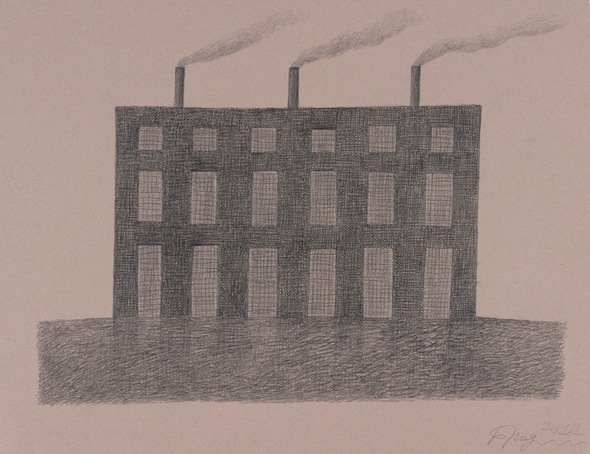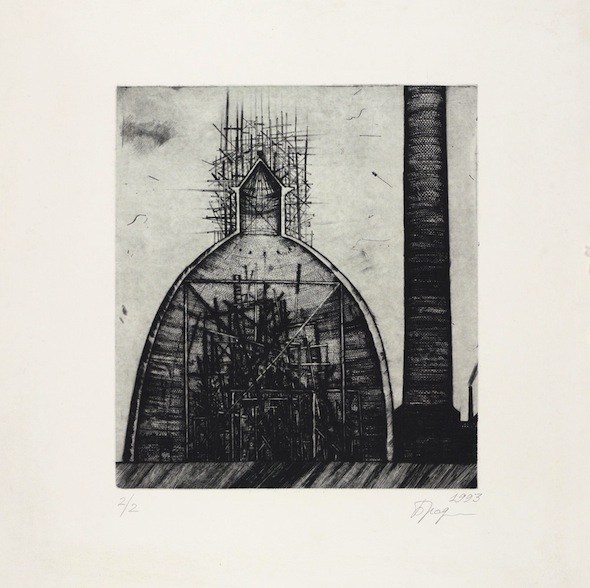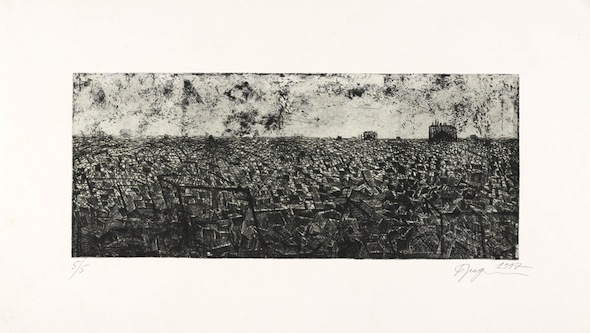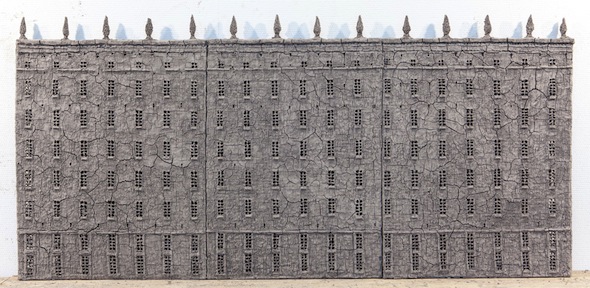Article by Madeleine Morley in Berlin; Monday, Mar. 23, 2015
 Alexander Brodsky – “Untitled”, pencil on paper; Courtesy Alexander Brodsky
Alexander Brodsky – “Untitled”, pencil on paper; Courtesy Alexander Brodsky
The Tchoban Foundation in Mitte seems the perfect location for an exhibition of Alexander Brodsky’s work. It’s a futuristic building of white blocks engraved with hieroglyphic-like symbols, and Brodsky’s art and architectural designs – part Ancient Egypt, part Orwellian hallucination and part Bridge of Sighs – are like the hidden scrolls from a future civilisation that have been hidden away in Tchoban’s monumental structure. Spiralling up the glass staircase, surrounded by reflecting metal, gold ornament and yellow light, you enter into the enclosed exhibition space and it’s almost as if you are an archaeologist uncovering a secret.
Alexander Brodsky hails from Moscow, a co-founder of the ‘paper architecture’ movement of the early 1980s: a group of young architects that responded rebelliously to the standardisation of Soviet Union building designs. To combat the bland and hollow strictness of late-modernism, Brodsky turned to fantasy and experimentation, supplementing traditional techniques of architectural rendering like pencil drawing and screen printing with sculptural materials like clay or bitumen roofing paper. His designs look like the kind of maps and Babel-like structures you’d find accompanying the index of a dense fantasy novel or in the pages of an 18th Century guide to Venice, but with smoke stacks, industrial brick ruins and disused basket ball hoops looming in the foreground. Brodsky depicts the future not as a world of glass surfaces and metal casing, but rather a space of rich history, of crumbling facades, great expanse, of clutter, wood and brick.
 Alexander Brodsky – “Untitled”; Courtesy of Alexander Brodsky
Alexander Brodsky – “Untitled”; Courtesy of Alexander Brodsky
The first room at the Tchoban Foundation showcases new works made especially for Berlin, drawn pieces that contain traces of the humble but shrewd hand of L. S. Lowry in the industrial depictions. Unlike the rationalised past of late-modernism, the sketches are direct emotional responses to a sense of space and place. A green wash over a dome-like rendering entitled Place of Overall evokes loneliness but also calm and contemplation, and in other drawings like Vanishing Point, monumental expanses of junkyard deserts are ghostly anarchic but also hint to dawning possibilities. The pictures make sense in Berlin: a city of spaces that are so emphatically used and disused, where a building’s function is no longer necessarily that which it was originally built for, and where new spatial narratives are constantly being written on top of the old ones.
 Alexander Brodsky – “Vanishing Points”, pen on paper; Courtesy of Alexander Brodsky
Alexander Brodsky – “Vanishing Points”, pen on paper; Courtesy of Alexander Brodsky
Aside from Brodsky’s physical structures (which aren’t on display), these illustrations are his best. They take you to another place, and the stories in the lines of ink are spellbinding. To get to the second part of the exhibition, you spiral up the glass staircase once more, and this new space contains Brodsky’s sculptural renderings of building facades. These works are less enticing than the drawings and can feel slightly repetitive, but they once more chime with Berlin, a city where highly ornamental and stripped-back facades combatively line the streets. The clay of these pieces splinters, like archeological finds from a by-gone society, but peering into the fragmented surface, lines of familiarity emerge from the cracks. The setting of the exhibition and its contents succeeds in drawing you into an world that seems imaginary, but like the best science-fiction novels, you’re able to see flashes of our own reality in Brodsky’s allegorical one.
 Alexander Brodsky – “Untitled”, unfired clay; Courtesy Alexander Brodsky
Alexander Brodsky – “Untitled”, unfired clay; Courtesy Alexander Brodsky
___________________________________________________________________________________
Additional Information
TCHOBAN FOUNDATION
“Works”- ALEXANDER BRODSKY
Exhibition: Mar. 14 – Jun. 5, 2015
Christinenstraße 18a (click here for map)
___________________________________________________________________________________
Madeleine Morley is a writer and editor from London. She studied English literature at Cambridge University (2013) and is currently in Berlin working on her MA thesis on 20th Century architecture and design for the Courtauld Institute of Art. www.madeleine-morley.tumblr.com



















